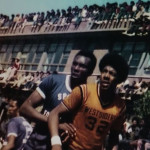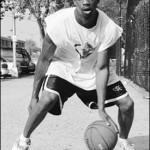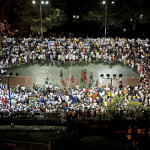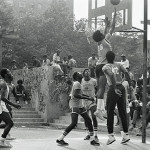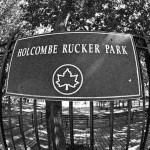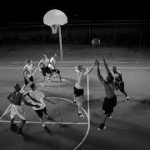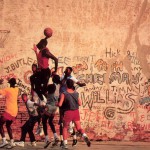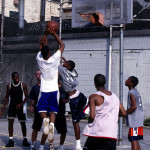 Streetball is passion. Though it is not always beautiful, one could easily call it streetart. It is a rough sport for tough men which does not allow much of weakness. Streetball means competition including embarassement and sometimes even humiliation of opponents. However, it is a basis for friendships because there is one basic ingredient that connects all players: the love for the game.
Streetball is passion. Though it is not always beautiful, one could easily call it streetart. It is a rough sport for tough men which does not allow much of weakness. Streetball means competition including embarassement and sometimes even humiliation of opponents. However, it is a basis for friendships because there is one basic ingredient that connects all players: the love for the game.
Without any referee the flow of the game completely relies on the respect and the communication between the players. As a matter of fact this established different rules on every court where spectacular tricks count more than accurately obeying the rules of basketball. Traveling is accepted if an opponent-embarassing move is the result. Streetball is a sport that involves every part of your body, even the mouth: If you master trashtalk you master the court. Distracting the counterpart and entertaining the crowd is as much important as the actual game. These various aspects made streetball such an attractive show as it is today.
 From its beginnings in the 70´s in the big cities of the US untill today the rules haven´t changed much but it´s got more and more influence within the street cultures around the world. Having its roots in the famous Rucker Park in New York City, streetball stepped up to other courts and cities where it was not enough for the boys to play on the team in their highschool.
From its beginnings in the 70´s in the big cities of the US untill today the rules haven´t changed much but it´s got more and more influence within the street cultures around the world. Having its roots in the famous Rucker Park in New York City, streetball stepped up to other courts and cities where it was not enough for the boys to play on the team in their highschool.
Having not many opportunities for spending their free time streetball was the only chance to emulate their big idols from the ABA and later the NBA. Rapidly the games attracted a steady audience celebrating the vicious tricks and ankle-breakers of their “court-stars”.
These players became local legends and got nicknames within the community like “the Destroyer”, “Helicopter” or “Pee Wee”. Even the famous Julius “Dr. J” Erving showed his talents at the Rucker Park tournament in 1971. Butch Purcell, who kept track of the stats at Rucker Park, said about him: “Man oh man! He was dunking on people like crazy. Back then the games were only held on the weekends, so that next week, the word was spreading like wildfire over the city. When we showed up that next week to play our game, the park was so packed that people couldn’t get in.” After having played for three years in the team of the University of Massachusetts and pulling off tremendous stats there, he was not quite known within the audience at Rucker Park.
 Nevertheless, Ernie Morris, a witness of the legendary encounter between Julius Erving and Joe Hammond claimed avidly: “I’ve seen so much great basketball in that park, but I’ve never seen anything like it since.” Thus, the legends around “Doc” laid the grounds for the incomparable success of streetball.
Nevertheless, Ernie Morris, a witness of the legendary encounter between Julius Erving and Joe Hammond claimed avidly: “I’ve seen so much great basketball in that park, but I’ve never seen anything like it since.” Thus, the legends around “Doc” laid the grounds for the incomparable success of streetball.
In the following decades it also got recognized by the dominating basketball brands like Nike and even induced brands like Kickz and AND1 to build their corporate identity on that specific form of basketball. This increasing interest by the economy was further promoted when Allen Iverson made it possible for a sheer streetballer from Philly to succeed in the NBA. He was beloved by the whole generation of young streetballers and established the streetstyle within the NBA.
Iverson´s popularity made it possible for Reebok who signed him to advertise the streetball culture and gain profit from it. Even today in the commercialized and digitalized environment of the NBA the biggest stars such as Kevin Durant or Kyrie Irving don´t hesitate to come out and demonstrate their skills on the court. One could argue that the pure streetball does not deserve this development because it lacks tradition and identity.
However, streetball is still played in its traditional form around the world and the main components sustained: When you dare to play streetball it strenghtens your credibility… even if you lose, you win the respect of everybody on the court.



